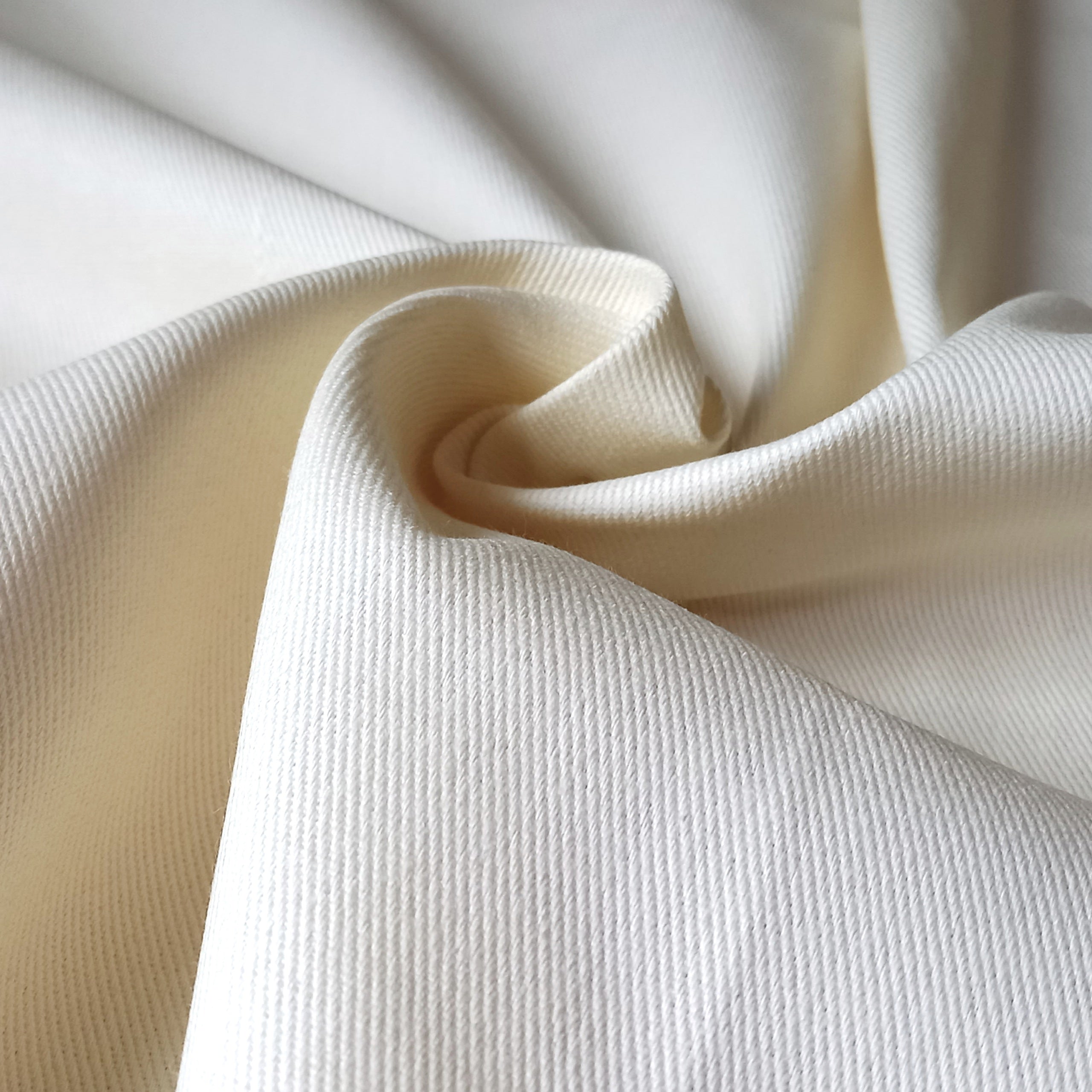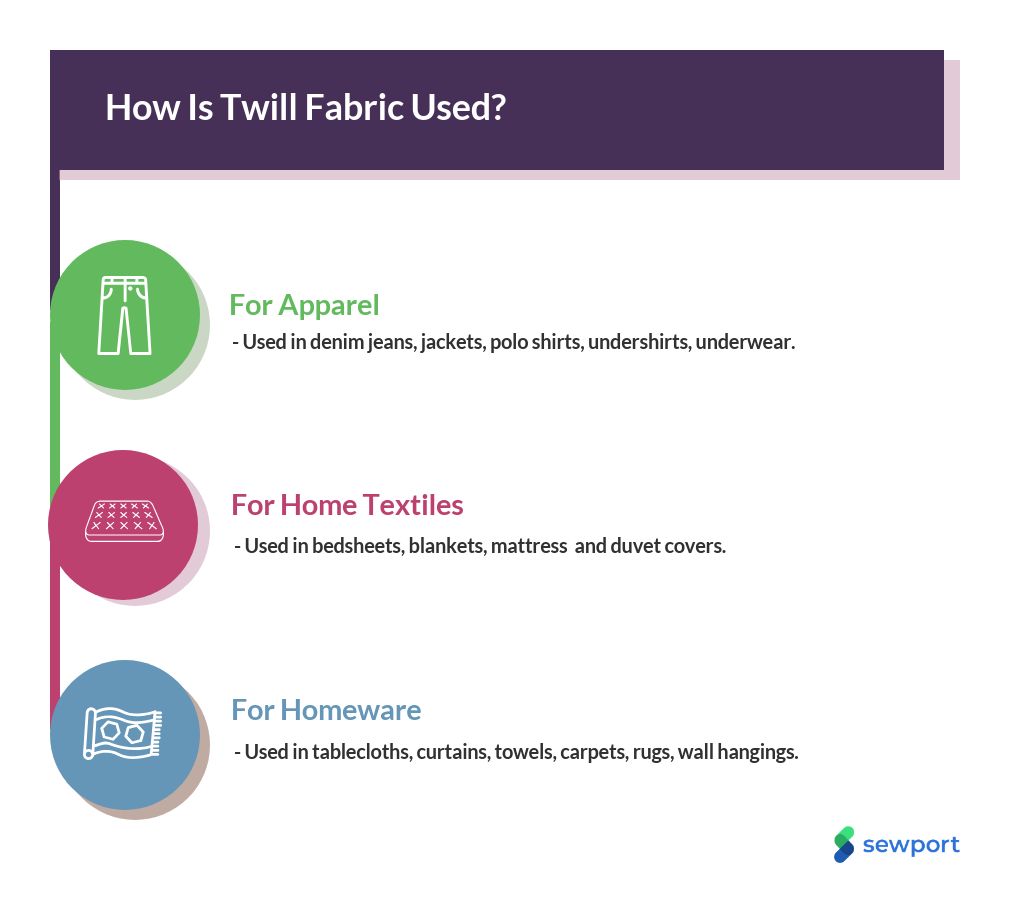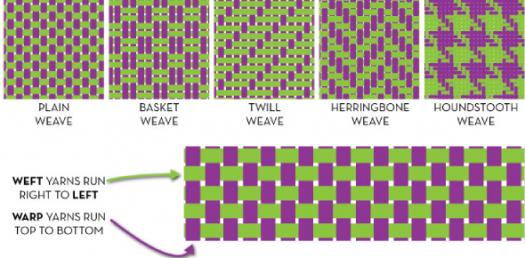Cotton twill is a durable fabric known for its distinct diagonal rib pattern. Its unique weave offers excellent drape, strength, and wrinkle resistance.

Table of Contents
- Understanding the Signature Twill Weave
- Key Properties of Cotton Twill Fabric
- How Is Cotton Twill Made? The Manufacturing Process
- What Are the Different Types of Twill?
- Where is Cotton Twill Commonly Used?
- Cotton Twill vs. Other Cotton Weaves
- How to Care for Cotton Twill Garments and Accessories

Understanding the Signature Twill Weave
The defining characteristic of any twill fabric is its unique weaving pattern, which creates a visible diagonal line, known as a *wale*. Unlike a basic plain weave where the weft (horizontal) yarn passes over and under a single warp (vertical) yarn, the twill weave involves the weft yarn passing over multiple warp yarns and then under one or more. This pattern is then shifted over by one yarn in the next row, creating the distinct, repeating diagonal texture.

This construction is what gives twill its superior strength and durability compared to plain-weave fabrics of similar fiber content. The diagonal structure distributes stress more evenly across the fabric, making it more resistant to tearing and showing wear. The direction of the diagonal—either to the left or right—can be manipulated to create different patterns, such as the famous herringbone or houndstooth designs.
The Mechanics of the Diagonal Rib Pattern
The diagonal rib, or wale, is a direct result of the offset in the weaving pattern. Imagine a pattern where the weft yarn goes over two warp yarns and under one (a 2/1 twill). In the next row, this entire pattern shifts one warp yarn to the right or left. This consistent, step-like progression across the fabric’s width forms the raised, diagonal lines you can see and feel. The angle of this diagonal can vary depending on the specific weave count, influencing the fabric’s texture and drape.
What Makes the Weave So Strong?
The strength of twill comes from its high thread count and the interlocking nature of its weave. With fewer interlacings than a plain weave, the yarns can be packed more tightly together. This creates a denser, more robust fabric. Furthermore, the floating yarns—those that pass over multiple opposing yarns—contribute to the fabric’s flexibility and ability to recover from wrinkling. This combination of density and flexibility makes cotton twill an exceptionally resilient material for items that endure regular use.
Key Properties of Cotton Twill Fabric
Cotton twill is prized for a specific set of characteristics that make it highly versatile. Its weave structure directly contributes to these functional and aesthetic qualities, making it a preferred choice for everything from durable workwear to sophisticated apparel and accessories.
The following table breaks down the essential properties that define this textile.
| Property | Description |
|---|---|
| Durability | The tight, diagonal weave creates a strong, tear-resistant fabric that withstands significant wear and tear. It holds its shape well over time. |
| Opacity | Due to its high thread count and dense construction, cotton twill is naturally opaque. It effectively hides what is underneath, making it ideal for trousers, jackets, and bag linings. |
| Drape | Twill drapes beautifully, falling in soft, structured folds rather than appearing stiff. This quality makes it suitable for tailored garments like jackets and trench coats. |
| Wrinkle Resistance | Compared to plain-weave cottons like poplin or canvas, twill is much less prone to wrinkling. The weave structure allows the fabric to recover from creases more easily. |
| Hides Stains | The textured surface and diagonal pattern can help camouflage minor dirt and stains better than a flat, plain-weave fabric, making it a practical choice for everyday items. |
| Breathability | As a fabric made from cotton fibers, twill retains natural breathability. It allows air to circulate, making it comfortable to wear in various climates. |
How Is Cotton Twill Made? The Manufacturing Process
The creation of cotton twill is a multi-step process that transforms raw cotton bolls into a finished, durable textile. Each stage is crucial for developing the fabric’s signature texture, strength, and appearance.
From Cotton Fiber to Yarn
The journey begins with harvesting raw cotton. The fibers are cleaned to remove seeds and debris, then carded—a process that aligns the fibers into a loose strand called a sliver. These slivers are then combed to remove shorter fibers, resulting in a smoother, stronger yarn. Finally, the fibers are spun into yarn of a specific thickness, which will determine the final weight and texture of the twill fabric.
The Weaving Process: Creating the Diagonal Pattern
This is where the magic happens. The spun cotton yarn is set up on a loom, with the vertical warp threads held under tension. The weft threads are then interlaced according to the specific twill formula. For example, in a 3/1 twill (common for denim), the weft thread passes over three warp threads and then under one. The loom automatically shifts this pattern by one thread for each new row, methodically building the characteristic diagonal wale that defines the fabric.
Finishing and Treatments
Once the fabric is woven, it undergoes several finishing processes. It may be washed and scoured to remove any impurities and oils from the weaving process. It is often dyed to achieve its final color; for example, denim is famously made with indigo-dyed warp yarns and white weft yarns. The fabric can also be treated to enhance its properties, such as being sanforized to prevent shrinkage or brushed to create a softer, peach-like surface known as “brushed twill.”
What Are the Different Types of Twill?
While all twill fabrics share the diagonal weave, variations in yarn, weight, and pattern have led to several distinct types. These variations are used for different purposes, ranging from heavy-duty workwear to lightweight, formal attire.
Denim: The Rugged Classic
Perhaps the most famous twill, denim is a heavy-duty cotton fabric typically made with a 3/1 weave. It is characterized by its indigo-dyed warp yarn and undyed weft yarn, which is why blue jeans are blue on the outside and lighter on the inside. Its ruggedness makes it the go-to material for jeans, jackets, and work apparel.
Chino: The Polished Staple
Chino is a lightweight cotton twill that was originally developed for military uniforms. It has a softer feel and a more subtle diagonal weave than denim. Chinos are known for their clean, polished look and are commonly used for trousers, shorts, and blazers. They are a cornerstone of smart-casual wardrobes.
Gabardine: The Tightly Woven Original
Invented by Thomas Burberry, gabardine is a tightly woven twill with a prominent diagonal rib on one side and a smooth surface on the other. While it can be made from wool or synthetic fibers, cotton gabardine is also common. Its dense weave makes it highly water-resistant and durable, famously used for trench coats and high-quality trousers.
Herringbone and Houndstooth: Patterned Variations
These are not different fabrics but rather patterns created by manipulating the twill weave. Herringbone is created by reversing the direction of the diagonal at regular intervals, forming a V-shaped or “broken” zig-zag pattern. Houndstooth is a two-tone pattern characterized by broken checks or abstract four-pointed shapes.
Where is Cotton Twill Commonly Used?
Thanks to its blend of durability, comfort, and refined appearance, cotton twill is one of the most versatile and widely used textiles in the world. Its applications span across multiple industries, from fashion and apparel to home goods and accessories.
Apparel: From Jeans to Jackets
This is the most common application for cotton twill. Denim jeans, chino pants, and structured jackets are staples in modern wardrobes. Its strength makes it perfect for trousers and outerwear that need to withstand frequent movement and washing. Lighter-weight twills are also used for shirts and dresses that require a good drape and structure.
Home Furnishings
In the home, cotton twill is a popular choice for upholstery, slipcovers, cushions, and curtains. Its durability ensures that furniture can withstand daily use, while its resistance to staining and wrinkling keeps it looking fresh. The tight weave also prevents dust and pet hair from embedding deeply into the fabric, making it easier to clean.
High-End Accessories and Linings
The interior of a product is just as important as the exterior, especially in luxury goods. That’s why premium brands like Beldtura Leather choose cotton twill to line their full-grain leather bags. Its strength prevents tearing from keys and other sharp objects, its smooth surface protects laptops and valuables from scratches, and its refined, opaque appearance complements the luxury of the leather itself. This choice reflects a commitment to quality that extends to every detail of the product.
Cotton Twill vs. Other Cotton Weaves
How does twill stack up against other common cotton weaves? Understanding the differences in construction helps clarify why each fabric is chosen for specific applications.
| Feature | Twill Weave | Plain Weave (e.g., Canvas, Poplin) | Satin Weave (Sateen) |
|---|---|---|---|
| Pattern | Visible diagonal lines (wales). | Simple over-one, under-one checkerboard pattern. No diagonal. | Smooth, lustrous surface with very few visible interlacings. |
| Durability | Very high. Resists tears and wears well over time. | Good. Strong and sturdy, but can be prone to tearing along the grain. | Lower. Prone to snagging due to long “floats” of yarn on the surface. |
| Drape | Excellent. Drapes smoothly and holds a structured shape. | Stiffer. Tends to be more rigid, especially in heavier fabrics like canvas. | Exceptional. Very fluid and flexible, drapes closely to the body. |
| Wrinkle Resistance | Good. Naturally resists and recovers from wrinkles. | Poor. Wrinkles very easily. | Moderate. Less prone to wrinkling than plain weave but more than twill. |
| Common Uses | Jeans, chinos, jackets, bag linings, upholstery. | Shirts, tote bags, sails, artist canvases. | Bed linens, formal wear, drapery linings. |
How to Care for Cotton Twill Garments and Accessories
Caring for cotton twill is generally straightforward, but following a few best practices will help maintain its structure, color, and longevity. Always check the manufacturer’s care label first, as finishes and dyes can require specific treatments.
For most 100% cotton twill items, machine washing in cold or cool water is recommended to prevent shrinkage and fading. It is best to turn garments like jeans and trousers inside out to protect the surface and color during the wash cycle. Use a gentle detergent and avoid bleach, which can weaken cotton fibers and strip color.
When drying, tumble dry on a low heat setting to minimize shrinkage. For best results, remove the item from the dryer while it is still slightly damp and hang it to air dry completely. This helps release wrinkles naturally. If ironing is needed, use a medium-hot setting, and iron on the reverse side of the fabric to protect the surface texture.

